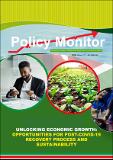| dc.description.abstract | The economy recorded stronger growth in 2023. The GDP growth rate increased from 4.9 in 2022 to 5.6 per cent in 2023. Across the sectors, activities in Agriculture rebounded strongly after four failed seasons. The agriculture sector expanded by 6.5 per cent in the period on the backdrop of favourable weather conditions and reduced farm input costs following the timely implementation of the government fertilizer and seed subsidy programme. The average growth rate for the services sector was 7.0 per cent, supported by the resilient performance of accommodation and food services, which grew by 33.6 per cent. Industrial activities moderated during the year, with manufacturing growth rate declining from 2.6 per cent in 2022 to 2.0 per cent in 2023. This reflects the negative impact of surging production costs as input prices and borrowing costs rose owing to a weakening shilling and slow growth in the global economy. ressure on domestic prices continued in 2023 as inflation rates crossed the government’s upper target band of 7.5 per cent. In the past, inflation rates crossed the target band during drought conditions, adversely affecting the availability and cost of food. In 2023, the inflation rate averaged 7.7 per cent compared to 7.6 per cent in 2022. This was due to a surge in fuel prices, driven by external oil market dynamics and, domestically, the implementation of the 16 per cent VAT on petroleum. The Monetary Policy Committee raised the Central Bank Rate (CBR) by 3.75 percentage points in 2023 to anchor inflation expectations. Further, in August 2023, the Central Bank of Kenya introduced an interest rate corridor spanning ±2.5 per cent around the CBR as a measure to reduce market volatility and uncertainty while improving the transmission of CBR to other interest rates. The government continued its commitment to the fiscal consolidation path, where the overall fiscal deficit narrowed from 5.6 per cent of GDP in 2022/23 to an estimated 4.9 per cent of GDP in 2023/24. This was achieved through prudent expenditure management and enhanced revenue mobilization efforts. Spending on education, housing and settlement, healthcare, and general economic affairs are strong drivers of productivity growth. Externally, the current account balance narrowed in 2023, supported by a resilient secondary income account (dominated by remittances) and improvement in merchandise trade balance triggered by 15.4 per cent growth in exports. | en |



